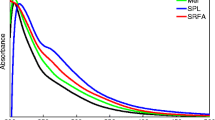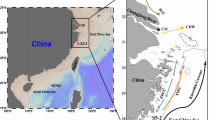Abstract
Humic substances (HS) are complex and heterogeneous mixtures of organic compounds that occur everywhere in the environment. They represent most of the dissolved organic matter in soils, sediments (fossil), water, and landfills. The exact structure of HS macromolecules has not yet been determined because of their complexity and heterogeneity. Various descriptions of HS are used depending on specific environments of origin and research interests. In order to improve the understanding of the structure of HS extracted from landfill leachate (LHS) and commercial HS from leonardite (HHS), this study sought to compare the composition and characterization of the structure of LHS and HHS using elemental composition, chromatographic (high-performance liquid chromatography (HPLC)), and spectroscopic techniques (UV–vis, FTIR, NMR, and MALDI-TOF). The results showed that LHS molecules have a lower molecular weight and less aromatic structure than HHS molecules. The characteristics of functional groups of both LHS and HHS, however, were basically similar, but there was some differences in absorbance intensity. There were also less aliphatic and acidic functional groups and more aromatic and polyphenolic compounds in the humic acid (HA) fraction than in the fulvic acid (FA) and other molecules (OM) fractions of both origins. The differences between LHS and HHS might be due to the time course of humification. Combining the results obtained from these analytical techniques cold improve our understanding of the structure of HS of different origins and thus enhance their potential use.

Chemical and structural and characterization of landfill leachate and leonardite humic fractions






Similar content being viewed by others
Abbreviations
- FA:
-
Fulvic acids
- HA:
-
Humic acids
- HFA:
-
Leonardite fulvic acids
- HHA:
-
Leonardite humic acids
- HHS:
-
Leonardite HS
- HOM:
-
Leonardite other molecules
- HS:
-
Humic substances
- LFA:
-
Leachate fulvic acids
- LHA:
-
Leachate humic acids
- LHS:
-
Leachate HS
- LOM:
-
Leachate other molecules
References
Vilar V, Rocha E, Mota F, Fonseca A, Saraiva I, Boaventura R. Treatment of a sanitary landfill leachate using combined solar photo-Fenton and biological immobilized biomass reactor at a pilot scale. Water Res. 2011;45(8):2647–58. doi:10.1016/j.watres.2011.02.019.
Sang N, Han M, Li GK, Huang M. Landfill leachate affects metabolic responses of Zea mays L. seedlings. Waste Manage. 2010;30:856–62. doi:10.1016/j.wasman.2010.01.023.
Zhao R, Novak JT, Goldsmith CD. Evaluation of on-site biological treatment for landfill leachates and its impact: a size distribution study. Water Res. 2012;46:3837–48. doi:10.1016/j.watres.2012.04.022.
Renou S, Givaudan JG, Poulaina S, Dirassouyan F, Moulin P. Landfill leachate treatment: review and opportunity. J Hazard Mater. 2008;150:468–93. doi:10.1016/j.jhazmat.2007.09.077.
Hou D, He J, Lü C, Wang W, Zhang F. Spatial distributions of humic substances and evaluation of sediment organic index on Lake Dalinouer, China. J Geophys Res. 2014;2014:1–13. doi:10.1155/2014/502597.
Xiaoli C, Shimaoka T, Qiang G, Youcai Z. Characterization of humic and fulvic acids extracted from landfill by elemental composition, 13C CP/MAS NMR and TMAH-Py-GC/MS. Waste Manage. 2008;28:896–903. doi:10.1016/j.wasman.2007.02.004.
Canellas LP, Zandonodi DB, Busato JG, Baldotto MA, Simoes ML, Martin-Neto L, et al. Bioactivity and chemical characteristics of humic acids from tropical soils sequence. Soil Sci. 2008;173(9):24–637. doi:10.1097/SS.0b013e3181847ebf.
Badis A, Ferradji FZ, Boucherit A, Fodil D, Boutoumi H. Characterization and biodegradation of soil humic acids and preliminary identification of decolorizing actinomycetes at Mitidja plain soils (Algeria). Afri J Microbiol Res. 2009;3(13):997–1007.
Piccolo A. The supramolecular structure of humic substances. A novel understanding of humus chemistry and implications in soil science. Adv Agron. 2002;75:57–134. doi:10.1016/S0065-2113(02)75003-7.
Kang KH, Shin HS, Park H. Characterization of humic substancs present in landfill leachates with different ages and implications. Water Res. 2002;36(16):4023–32. doi:10.1016/S0043-1354(02)00114-8.
Abbt-Braun G, Lankes U, Frimmel FH. Structural characterization of aquatic humic substances—the need for a multiple method approach. Aquat Sci. 2004;66:151–70. doi:10.1007/s00027-004-0711-z.
Chung TL, Chen JS, Chiu CY, Tian G. 13C-NMR spectroscopy studies of humic substances in subtropical perhumid montane forest soil. J For Res. 2011;17:1–10. doi:10.1007/s10310-011-0319-9.
Nasir S, Sarfaraz TB, Verheyen TV, Chaffee AL. Structural elucidation of humic acids extracted from Pakistani lignite using spectroscopic and thermal degradative techniques. Fuel Process Technol. 2011;92(5):983–91. doi:10.1016/j.fuproc.2010.12.020.
Fernández-Gómez MJ, Nogales R, Plante A, Plaza C, Fernández JM. Application of a set of complementary techniques to understand how varying the proportion of two wastes affects humic acids produced by vermicomposting. Waste Manage. 2015;35:81–8. doi:10.1016/j.wasman.2014.09.022.
Sierra MD, Giovanela M, Parlanti E, Soriano-Sierra EJ. 3D-Fluorescence spectroscopic analysis of HPLC fractionated estuarine fulvic and humic acids. J Braz Chem Soc. 2006;17(1):113–24. doi:10.1590/S0103-50532006000100017.
Tahiri A, Destain J, Thonart P, Druart P. In vitro model to study the biological properties of humic fractions from landfill leachate and leonardite during root elongation of Alnus glutinosa L. Gaertn and Betula pendula Roth. Plant Cell Tiss Organ Cult. 2015;122(3):739–49. doi:10.1007/s11240-015-0807-2.
Thonart P, Steyer E, Drion R, Hiligsmann S. La gestion biologique d’une décharge. Tribune de l’Eau. 1998;590(591):3–12.
Sang N, Li GK, Xin XY. Municipal landfill leachate induces cytogenetic damage in root tips of Hordeum vulgare. Ecotoxicol Environ Saf. 2006;63:469–73. doi:10.1016/j.ecoenv.2005.02.009.
Kjeldsen P, Barlaz MA, Rooker AP, Baum A, Ledin A, Christensen TH. Present and long-term composition of MSW landfill leachate. A review. Crit Rev Environ Sci Technol. 2002;32(4):297–336. doi:10.1080/10643380290813462.
Tahiri A, Destain J, Thonart P, Druart P. Valorization and properties of landfill leachates humic substances. J Mater Environ Sci. 2014;5(S2):2495–8.
Berthe C. Etude de la Matière Organique contenue dans des lixiviats issus de différentes filières de traitement des déchets ménagers et assimilés. France: Thèse de doctorat, Université de Limoges; 2006.
François V. Détermination d’indicateurs d’accélération et de stabilisation de déchets ménagers enfouis. Etude de la recirculation de lixiviats sur colonnes de déchets. Thèse de doctorat, Université de Limoges. 2004.
Rose MT, Patti AF, Little KR, Brown AL, Jackson WR, Cavagnaro TR. A meta-analysis and review of plant-growth response to humic substances: practical implications for agriculture. Adv Agron. 2014;124:37–89. doi:10.1016/B978-0-12-800138-7.00002-4.
Ryan D, Zhu B. Humic substances: high performance liquid chromatography. Ref Mod Chem Mol Sci Chem Eng. 2013. doi:10.1016/B978-0-12-409547-2.04781-8.
Egeberg PK, Alberts JJ. Determination of hydrophobicity of NOM by RP-HPLC, and the effect of pH and ionic strength. Water Res. 2002;36:4997–5004. doi:10.1016/S0043-1354(02)00228-2.
Her N, Amy G, Foss D, Cho J. Variations in molecular weight estimation by HP-size exclusion chromatography with UVA versus online DOC detection. Environ Sci Technol. 2002;36:3393–9. doi:10.1021/es015649y.
Wu FC, Evans RD, Dillon PJ. High-performance liquid chromatographic fractionation and characterization of fulvic acid. Anal Chim Acta. 2002;464:47–55. doi:10.1016/S0003-2670(02)00476-2.
Wu FC, Evans RD, Dillon PJ, Cai YR. Rapid quantification of humic and fulvic acids by HPLC in natural waters. Appl Geochem. 2007;22:1598–605. doi:10.1016/j.apgeochem.2007.03.043.
Hutta M, Gora R, Halko R, Chalanyova M. Some theoretical and practical aspects in the separation of humic substances by combined liquid chromatography methods. J Chromatog A. 2011;1218:8946–57. doi:10.1016/j.chroma.2011.06.107.
Chen J, Gu B, Le Boeuf EJ, Pan H, Dai S. Spectroscopic characterization of the structural and functional properties of natural organic matter fractions. Chemosphere. 2002;48:59–68. doi:10.1016/S0045-6535(02)00041-3.
Pansu M, Gautheyrou J. Handbook of soil analysis: mineralogical, organic and inorganic methods. Berlin Heidelberg: Springer; 2006. p. 399–451.
Chin YP, Aiken G, O’Loughlin E. Molecular weight, polydispersity, and spectroscopic properties of aquatic humic substances. Environ Sci Technol. 1994;28(11):1853–8. doi:10.1021/es00060a015.
Uyguner CS, Bekbolet M. Evaluation of humic acid photocatalytic degradation by UV–Vis and fluorescence spectroscopy. Catal Today. 2005;101(3):267–74. doi:10.1016/j.cattod.2005.03.011.
Tahiri A, Destain J, Druart P, Thonart P. Propriétés physico-chimiques et biologiques des substances humiques en relation avec le développement végétal. Biotechnol Agron Soc Environ. 2014;18(3):336–45.
Zhang L, Li A, Lu Y, Yan L, Zhong S, Deng C. Characterization and removal of dissolved organic matter (DOM) from landfill leachate rejected by nanofiltration. Waste Manage. 2009;29:1035–40. doi:10.1016/j.wasman.2008.08.020.
Atkins P, De Paula J. Physical chemistry. 9th ed. New York: Oxford University Press; 2009.
Baigorri R, Fuentes M, González-Gaitano G, García-Mina JM, Almendros G, González-Vila FJ. Complementary multianalytical approach to study the distinctive structural features of the main humic fractions in solution: gray humic acid, brown humic acid, and fulvic acid. J Agric Food Chem. 2009;57(8):3266–72. doi:10.1021/jf8035353.
Baglieri A, Vindrola D, Gennari M, Negre M. Chemical and spectroscopic characterization of insoluble and soluble humic acid fractions at different pH values. Chem Bioll Technol Agr. 2014;1:9. doi:10.1186/s40538-014-0009-x.
Russell, Stokes AR, Macdonald H, Muscolo A, Nardi S. Stomatal responses to humic substances and auxin are sensitive to inhibitors of phospholipase A2. Plant Soil. 2006;283:175–85. doi:10.1007/s11104-006-0011-6.
Schiavon M, Pizzeghello D, Muscolo A, Vaccaro S, Francioso O, Nardi S. High molecular size humic substances enhance phenylpropanoid metabolism in maize (Zea mays L.). J Chem Ecol. 2010;36:662–9. doi:10.1007/s10886-010-9790-6.
Trubetskoj O, Hatcher PG, Trubetskaya OE. 1H-NMR and 13C-NMR spectroscopy of chernozem soil humic acid fractionated by combined size-exclusion chromatography and electrophoresis. Chem Ecol. 2010;26(4):315–25. doi:10.1080/02757541003785825.
Ertani A, Francioso O, Tugnoli V, Righi V, Nardi S. Effect of commercial lignosulfonate-humate on Zea mays L. metabolism. J Agric Food Chem. 2011;59:11940–8. doi:10.1021/jf202473e.
Adani F, Genevini P, Tambone F, Montoneri E. Compost effect on soil humic acid: a NMR study. Chemosphere. 2006;65:1414–8. doi:10.1016/j.chemosphere.2006.03.070.
Fan TWM. Metabolite profiling by one- and two-dimensional NMR analysis of complex mixtures. Progr Nucl Magn Reson Spectrosc. 1996;28:161–219. doi:10.1016/0079-6565(95)01017-3.
Muscolo A, Sidari M, Attinà E, Francioso O, Tugnoli V, Nardi S. Biological activity of humic substances is related to their chemical structure. Soil Sci Soc Am J. 2007;71:75–85. doi:10.2136/sssaj2006.0055.
Kim HT. Humic matter in soil and the environment. Principles and controversies. CRC Press 294p. 2014.
Hillenkamp F, Peter-Katalinic J. MALDI MS: a practical guide to instrumentation, methods and applications. Hardcover. Wiley-Blackwell, 480p. 2007.
Lyubomirova V, Djingova R. Mass spectrometric techniques for characterisation of platinum–humic substance complexes in soil and street dust samples. Chem Spec Bioavailab. 2013;25(4):223–34. doi:10.3184/095422913X13844520283032.
Mugo SM, Bottaro CS. Characterization of humic substances by matrix-assisted laser desorption/ionization time-of-flight mass spectrometry. Rapid Commun Mass Spectrom. 2004;18:2375–82. doi:10.1002/rcm.1635.
Gajdǒsová D, Pokorná L, Láska K, Prosěk P, Havel J. Are there humic acids in Antarctica? In: Davies G, Ghabbour EA, editors. Humic substances structures, models and functions. Cambridge: Royal Society of Chemistry; 2001. p. 121–31.
Peña-Méndez EM, Gajdošová D, Novotná K, Prošek P, Havel J. Mass spectrometry of humic substances of different origin including those from Antarctica. A comparative study. Talanta. 2005;67:880–90. doi:10.1016/j.talanta.2005.03.032.
Gajdǒsová D, Novotná K, Prosěkb P, Havela J. Separation and characterization of humic acids from Antarctica by capillary electrophoresis and matrix-assisted laser desorption ionization time-of-flight mass spectrometry. Inclusion complexes of humic acids with cyclodextrins. J Chromato A. 2003;1014:117–27. doi:10.1016/S0021-9673(03)01040-9.
Acknowledgments
The authors would like to thank the TRADECORP Company for supplying its “Humifirst” formulation and the Van Gansewinkel Groep (Cour-au-Bois landfill) for providing the leachate needed to conduct our study. We also thank Maesen Ph. (GxABT-ULg) for the chemical analysis; De Pauw E. and Smargiasso N. (GIGA-Ulg) for the MALDI-TOF analysis; and Salvé A., Chemotti C., and Byttebier V. for their help in the chemical analysis and their technical assistance in the laboratory.
Author information
Authors and Affiliations
Corresponding author
Ethics declarations
Conflict of interest
The authors declare that they have no competing interests.
Rights and permissions
About this article
Cite this article
Tahiri, A., Richel, A., Destain, J. et al. Comprehensive comparison of the chemical and structural characterization of landfill leachate and leonardite humic fractions. Anal Bioanal Chem 408, 1917–1928 (2016). https://doi.org/10.1007/s00216-016-9305-6
Received:
Revised:
Accepted:
Published:
Issue Date:
DOI: https://doi.org/10.1007/s00216-016-9305-6




